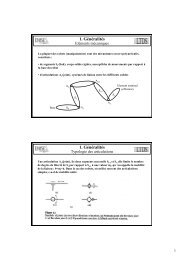q - Rosario Toscano - Free
q - Rosario Toscano - Free
q - Rosario Toscano - Free
You also want an ePaper? Increase the reach of your titles
YUMPU automatically turns print PDFs into web optimized ePapers that Google loves.
3. (Update the pi’s and pg). For each particle, update the local best position found so far<br />
i<br />
i<br />
i<br />
using the following rule: If J ( q ( k))<br />
< J ( p ) then p<br />
i<br />
= q ( k),<br />
i = 1,<br />
L,<br />
N . Update the<br />
global best position as follows: p = min J ( p ) .<br />
g<br />
arg<br />
1≤i≤<br />
N<br />
4. (Stopping rule). Terminate the algorithm if the stopping rule is satisfied (i.e. a maximum<br />
number of iteration has been reached or no further improvement is found); else go to 2.<br />
Initialization. The initial population of particles is usually generated at random by sampling the<br />
search space according to a uniform distribution. This can be done in a similar way as in GA, see<br />
section 2.1.1. The initial velocities can also be generated at random but this requires defining a<br />
sample space. To this end we can introduce a parameter bound vmax. The initial velocities can then<br />
nq<br />
be obtained by sampling the space = { v ∈ R : −1v<br />
≤ v ≤ 1v<br />
}<br />
i<br />
V according to a uniform<br />
distribution. The symbol 1 represents the unit vector and ≤ e indicates element-by-element<br />
inequality. The swarm size N is a user defined parameter. Sizes of 20-150 particles are common<br />
in practice. Concerning this parameter, the same things as in GA apply (see section 2.1.1).<br />
Stopping rule. A simple stopping criterion is to fix a maximum allowed number of iterations<br />
MaxIter. This parameter is required to use a varying inertia weight (see relation (16)).<br />
However, the use of this criterion alone cannot guarantee the convergence of the algorithm to a<br />
solution. Instead, it is preferable to stop the algorithm when no improvement is found after a<br />
given number of iteration NI. To this end we can use the same stopping rule as in GA, but in our<br />
experiments, we have found better to stop the algorithm when the following condition is satisfied:<br />
The algorithm stops when: J ( pg<br />
( k))<br />
− J ( pg<br />
( k − N I )) ≤ ρPSO<br />
(18)<br />
where k is the current iteration, ρPSO is the minimum level of improvement desired on NI<br />
iterations, and pg (l)<br />
is the global best found at iteration l. Possible values of ρPSO and NI are,<br />
respectively: 0.001 and 50.<br />
Parameter of PSO algorithm. As in GA, there are many choices to do for a practical<br />
implementation of the PSO algorithm. In particular: the swarm size (N), the probability<br />
distributions generating the initial positions and the initial velocities, the maximal allowed<br />
velocity, the bound of the inertia weight and its rule of decrease, the cognitive factor and the<br />
social factor. Table 4 summarizes the choices most widely adopted in practical applications. The<br />
values given in this table are only indicatives and some variations can be required to improve the<br />
performance. But this of course is not at all easy to do particularly when the number of<br />
parameters is important.<br />
Table 4. Parameters of a standard PSO Algorithm.<br />
Swarm size (N) 20 ≤ N ≤ 150<br />
Initial positions randomly (uniformly) generated in the search space<br />
Maximal velocity (vmax) vmax can be set to the maximal bound of q<br />
Initial velocities randomly (uniformly) generated in [-vmax, vmax] n<br />
Bounds of the inertia weight (wmin, wmax) 0.3 ≤ wmin ≤ 0.4, 0.8 ≤ wmax ≤ 0.9<br />
Rule of decrease of the inertia weight Linear from wmax to wmin<br />
Cognitive factor (c1) c1 ≈ 2<br />
Social factor (c2) c2 ≈ 2<br />
max<br />
e<br />
e<br />
max



